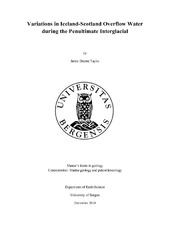| dc.description.abstract | There is a growing body of evidence suggesting that the density and speed of the Nordic Seas overflows experienced significant changes on both centennial and multi-millennial time scales throughout the penultimate interglacial period. However, the exact nature and magnitude of this variability remains poorly constrained. Iceland-Scotland Overflow Water (ISOW), which constitutes the eastern branch of the overflows, forms as a result of the cooling and subsequent sinking of salty, near-surface waters in the Nordic Seas. This cold, dense water mass flows southward as a deep boundary current forming the lower limb of the Atlantic Meridional Overturning Circulation (AMOC). It is balanced by the inflow of warm, salty surface waters originating in the tropics. Climate models forecast significant decreases in AMOC by the end of the century due to changes in evaporation and precipitation patterns in a warmer climate. These projections suggest a strong sensitivity of deep water currents to warming or freshening, but have large uncertainties. Thus, it is unclear how sensitive ocean circulation is to potential future changes. Information about ocean circulation in the past provides real world constraints for understanding ocean sensitivity to warmer-than-present conditions. Here I reconstruct relative changes in the near-bottom flow strength of ISOW using mean sortable silt (SS) from a high sedimentation rate site (53°03.40’N, 33°31.78’W; water depth 3024 m), which is located under the direct path of ISOW on the extreme southern end of the Gardar Drift. I pair this new high-resolution sedimentological record with existing geochemical data (δ^13C) for Site U1304 in order to test the hypothesis that overturning circulation experienced significant, rapid changes during the peak of the last interglacial (LIG) (128-116 kyr BP). My SS results demonstrate significant millennial scale flow variability throughout the LIG, with a persistent pattern of abrupt, centennial scale variability superimposed over the longer-term trends. The transient, centennial scale oscillations experience maximum magnitude variability during the period of highest flow speed, suggesting that the main axis of ISOW was proximal to the site at this time. Compared to SS, δ^13C shows persistent, centennial scale variability superimposed over relatively stable and high values. This long-term stability in bottom water chemistry suggests that ISOW remained the dominant water mass over the site in spite of the significant variability in flow vigor that occurred throughout the LIG. The clearest feature in the LIG bottom flow record is a gradual acceleration starting at ~124 kyr BP followed by an abrupt deceleration at ~120 kyr BP. This trend is broadly consistent in both timing and magnitude to similar trends observed at nearby sites, and have been postulated to be linked to increases (acceleration) and decreases (deceleration) in convection intensity. Taken together, my observations confirm the notion that LIG deep circulation varied significantly on millennial time-scales, and reveal that circulation also oscillated on shorter (centennial) timescales. Circulation variability through a period of warmer-than-present climate confirms model results suggesting that the deepest branches of AMOC remain sensitive to buoyancy changes in Nordic Seas source regions in a warm(er) climate. | en_US |
